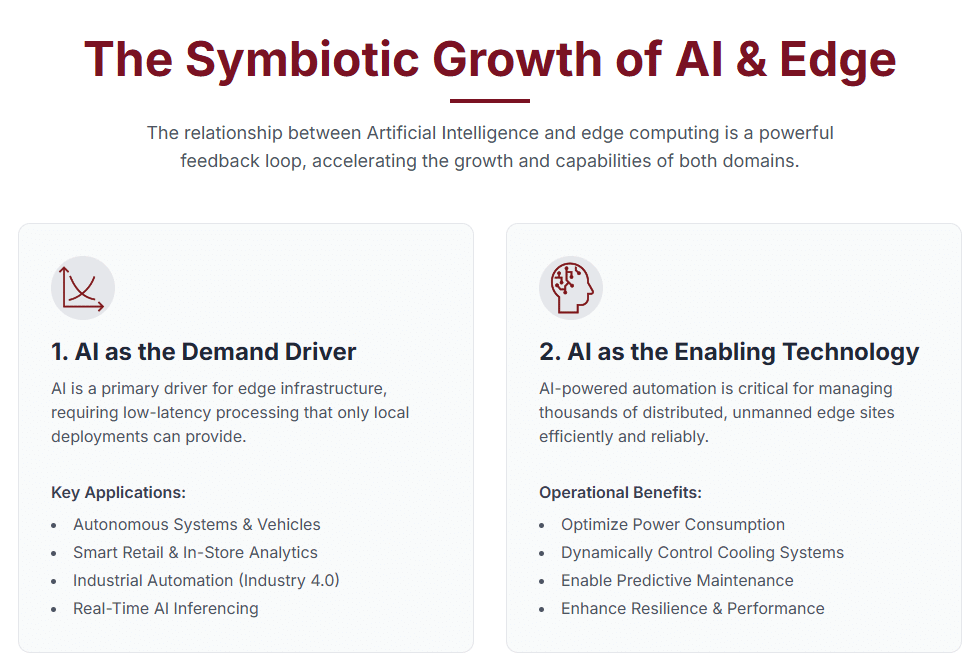The Symbiotic Growth of AI and Edge Infrastructure
Published on July 11, 2025,
by
The Symbiotic Growth of AI and Edge Infrastructure
The convergence of AI and edge infrastructure is not just a technological coincidence—it’s a powerful, mutually reinforcing relationship that is reshaping the digital landscape. As artificial intelligence (AI) becomes more embedded in everyday applications, the need for edge computing grows. At the same time, edge infrastructure is becoming smarter and more efficient thanks to AI-driven automation and optimization.
This dynamic feedback loop is fueling innovation across industries, from autonomous vehicles and smart cities to healthcare and industrial automation. Let’s explore how this synergy works, why it matters, and what it means for the future of digital infrastructure.
AI as a Driver of Edge Infrastructure
One of the most significant forces behind the expansion of edge computing is the growing demand for real-time AI inferencing. In many modern applications, decisions must be made instantly based on live data. This is especially true in scenarios like:
- Autonomous vehicles, which must process sensor data in milliseconds to ensure safety.
- Smart retail, where in-store analytics and personalized recommendations rely on immediate insights.
- Industrial automation, where machinery must respond to changing conditions in real time.
These use cases require ultra-low latency and high-speed data processing—capabilities that centralized cloud data centers often cannot deliver due to distance and bandwidth limitations. That’s where edge infrastructure comes in. By placing compute resources closer to the data source, edge data centers enable real-time AI inferencing without the delays of round-trip communication to the cloud.
In short, AI is a primary demand driver for edge infrastructure. As AI applications proliferate, so too does the need for localized, high-performance computing environments.
AI as an Enabler of Edge Efficiency
While AI drives the need for edge computing, it also plays a crucial role in making edge infrastructure more efficient and scalable. Managing a distributed network of thousands of edge sites—often unmanned and located in remote areas—is a complex challenge. Traditional manual operations simply don’t scale.
This is where AI steps in as an enabler. Intelligent automation platforms powered by AI are being used to:
- Optimize power consumption by dynamically adjusting workloads and energy use.
- Control cooling systems in real time to maintain optimal operating temperatures.
- Enable predictive maintenance by identifying early signs of equipment failure before they cause downtime.
These capabilities not only reduce operational costs but also enhance the resilience and performance of edge deployments. In essence, AI is making edge infrastructure smarter, more autonomous, and more reliable.
The Financial Scale of the Synergy
The economic implications of this symbiotic relationship are massive. The market for AI-specific data centers was valued at $15.02 billion in 2024 and is projected to reach $93.60 billion by 2032, representing a compound annual growth rate (CAGR) of 26.8%.
Much of this investment is being driven by hyperscale cloud providers upgrading their infrastructure to support AI workloads. These investments in advanced hardware (like GPUs and AI accelerators), software platforms, and operational expertise are not confined to the cloud. They are also enabling more sophisticated and capable edge deployments.
As the capabilities of AI infrastructure improve, they trickle down to the edge—bringing with them the tools and technologies needed to support increasingly complex and mission-critical applications.
Real-World Impact Across Industries
The synergy between AI and edge infrastructure is already delivering tangible benefits across a wide range of sectors:
- Healthcare: Real-time analysis of patient data from wearable devices and medical imaging systems enables faster diagnoses and more personalized care.
- Manufacturing: AI-powered visual inspection systems running at the edge detect defects instantly, improving quality control and reducing waste.
- Telecommunications: Edge AI helps optimize network performance and deliver seamless experiences for 5G users.
- Energy and Utilities: Smart grids use edge AI to balance loads, detect faults, and improve energy efficiency.
These examples illustrate how the combination of AI and edge computing is not just theoretical—it’s actively transforming how businesses operate and deliver value.
Looking Ahead: A Smarter, Faster Future
As both AI and edge technologies continue to evolve, their interdependence will only deepen. We can expect to see:
- More intelligent edge devices capable of running complex AI models locally.
- Greater automation in edge operations, reducing the need for human intervention.
- Expanded use cases in areas like agriculture, logistics, and public safety.
The future of digital infrastructure will be defined by systems that are not only distributed and scalable but also intelligent and adaptive. The fusion of AI and edge infrastructure is laying the foundation for this future—one where data is processed where it’s needed most, and decisions are made in real time.
Final Thoughts
The relationship between AI and edge infrastructure is a textbook example of technological synergy. AI drives the demand for edge computing, while edge infrastructure enables AI to operate at the speed and scale modern applications require. Together, they are accelerating the pace of innovation and redefining what’s possible in the digital world.
Organizations that recognize and invest in this symbiotic growth will be better positioned to lead in an increasingly data-driven, real-time economy. The edge is getting smarter—and AI is the reason why.


